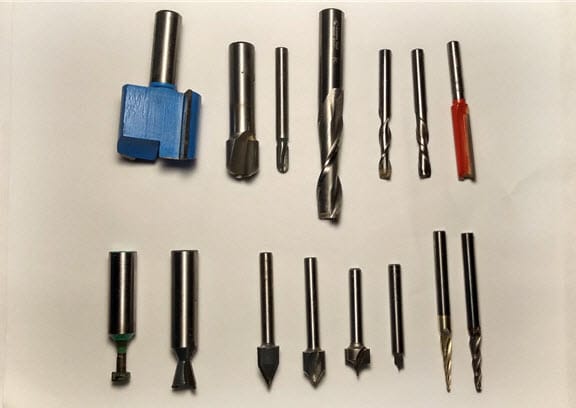Bits are an integral part of any CNC router’s function; the bits are what determine the resolution, carving type, and the material you can work on. We owe today’s creative possibilities achievable with CNC machines to these small but powerful CNC setup parts. But how much do you know about the different types of CNC router bit profile names and their uses?
The CNC router bit profiles include fly cutter (flattening a surface), V bits (vector carving and decorative effects), bowl and tray (inner radius), and spiral end mill (plywood, hardwood, or hard plastics). Other popular options include the straight blade end mill (epoxy and plastic) and ball nose bits (smooth 3D contouring).
Using the right CNC bit for a project doesn’t just ensure successful finishes; it’s also your best bet for keeping material costs from spiraling beyond your budget. The rest of this article will take a closer look at some of the most popular CNC router bit profiles and where they’re used!
Spoilboard/Flattening Bits
These bits are often multi-blade cutters used on a mill, most often used as surfacing tools. CNC machinists looking for the finest surface finish often work with fly cutting/flattening bits. When combined with carbide inserts, these bits can ensure the best possible finish and longevity. If you want the finish completed in as few passes as possible, it’s best to work with a large-diameter flattening bit.
These bits are offered as large as 4″ in diameter. Make sure that your router motor or spindle can slow down to a speed that will keep the use of these large diameter bits safe to use. Check the bit manufacturer for the recommended speed of the bit you are using. In general terms, bits that are 1” to 2” (25mm to 50mm) should spin at 18,000 RPM which most variable speed router moors can handle. Larger bits need to run even slower.
For a woodworking CNC hobbyist, a 2: bit is about as large as we need to go. I have seen people flatten their waste board with a .25″ bit. I would also recommend using a 0.5″ shank bit for anything over 2″
Router motors that have a “Slow Start” feature along with speed control feedback to help maintain a constant RPM will work even better with these large diameter bits.
However, for the beginner or hobbyist woodworker, a more practical approach would be to use large diameter (.5” [13mm] to 1.5” [38mm] ) flat end mill bit to make the waste board flat again.
These large diameter cutters can also cut wide dados and grooves with light passes.
Here are a few examples if you are interested in looking at wasteboard flattening bits.
V Bits
V bits deliver a V-shaped profile in any piece of material, most useful for creating a decorative effect and engraving designs on flat surfaces — such as cabinet faces and signs. These bits also come in handy for “fluting” (which involves creating shallow grooves that run throughout the length of a column) and engraving ridges in panels to deliver the beadboard effect.
V bits come in various diameters and angles, which determine the depth and width of any cut. Some examples include the following:
- 90-Degree V Bits. These are best for making decorative panels and moldings. They are also valuable for signage and chamfer making, especially when there’s a guide or template in use.
- 45/60 Degree V Bits. These deliver cuts deeper than what you’ll get with a 90-degree V bit. They are often the preferred option for machinists looking for deep engraving and more detailed lettering, though they’re also great for making deeper fluted columns, signs, and beadboard look on panels.
Bowl and Tray Bits
Bowl and tray bits feature a round corner that shapes the inner radius of materials being worked on while the sides and bottoms deliver a smooth, flat surface. Bowl and tray bits simplify pattern work a great deal, especially when fitted with top bearings. They are popular for working on specialty or craft items, cutting boards, boxes, trays, bowls, etc. Machinists also rely on them when creating raised sign lettering.
Spiral End Mill
Spiral end mill bits help achieve a smooth finish on hard plastics, mainly phenolic and acrylic. The spiral shape of the blades makes a shearing cut rather than the brute force cut made by straight blade cutters. The modified cutter angle here ensures a better finish when working on plastics compared to other bit profiles. While the spiral blades do make a better cut, they also introduce a tendency to push or pull the workpiece in relation to the table. There are different types of spiral end mill bits. They include the following:

Up Spiral
Up spiral end mill bits are helpful for most material removal and milling projects because they pull the chips from the material upwards and away from the tool’s work path. This helps prevent tool breakage and can help the bit last longer. However, some machinists use other spiral end mill bit variants for the final pass, even when they use this one on a project. See my post on Up-Cut Bits for more information.
Down Spiral
Down spiral end mill bits are excellent general-purpose tools for working on soft and medium-hard materials, including foam, plastic, and wood. They are very good at keeping materials such as plywood from splintering in the middle on the top of the workpiece. See my article on Down-Cut Bits for more information
Compression
A compression spiral end mill is handy when making a full depth cut on veneer finished material, ensuring they leave clean edges on the material’s bottom and top surfaces.
A compression bit will pull material chips upwards around the bottom of the stock and downward around the top. The result is chip-free surfaces that are hard to avoid in furniture and cabinet parts. Compression spiral end mills are a popular option for CNC work on solid wood, MDF, plywood, and melamine.
One thing to note about compression bits on the CNC: The first pass has to be deeper than the up-cut portion of the bit. Otherwise, the up-cut portion of the bit will produce chip-out on the top layers of the workpiece and void out any benefit of the down-cut portion of the compression bit. Read more about compression bits for more information
Straight Blade End Mill Bits
Straight blade end mill bits are typically single-ended and come with a zero-degree helix, most popular when working on epoxy and glass composites and plastics. They may also work in special profile milling applications. The straight blade keeps the edges from fraying and ensures a better surface finish when compared to helical general-purpose end mill bits. These bits also come in a variety of diameter sizes ranging from 1/8” to 1” (0.32cm to 2.54cm).
In woodworking, the straight blade end mill is often used to make dados, grooves and rabbets (or rebates). Larger diameters will also be effective at spoil board flattening.
Ball Nose Bits
Ball nose bits are more for fine detail passes and smooth contouring, which is why you’re likely to find them in use for complex 3D carvings. These bits come with rounded ends, allowing them to produce smooth curves that would otherwise be impossible when working with any typical flat end bits.
Ball nose bits with smaller diameters are used in projects that involve intricate detail, while the larger bits are helpful for smoother projects that feature more gradual slopes. CNC machinists also use these bits when routing fluted channels and columns on surfaces like countertops edges and cutting boards. Some variants of ball nose bits that are commonly in use include:
Straight Ball Nose
Spiral ball nose bits are ideal for routing composites, hard and soft plastic, wood, and other solid-surface materials, though you’ll also find this in use for 2D and 3D carving, edge work, and grooving. This variant has an extra-long cutting length which makes cutting deeper grooves easier. It also makes deep cuts in several passes to increase the bit’s shelf life and enhance the cut’s quality.
In this case, “Straight” is referring to the resulting wall created by the cutter. Unlike the tapered ball nose, which creates a tapered wall, the straight ball nose leaves a straight wall.
Tapered Ball Nose
Tapered ball nose bits are for 2D and 3D CNC profiling. It’s also helpful in carving plastic, aluminum, and wood, making it common to use tapered ball nose bits for projects like:
- 3D millwork
- Dimensional signage
- Deep profiling
- Large scale precision 2D and 3D carving
- Model-making in abrasive EPS foam
- 2D and 3D pattern making for cabinet, furniture, and jewelry mold making.
Beadboard CNC Bit
These are automated shaping tools that generally create flute or bead patterns. The flute patterns feature multiple beads, while the bead pattern is a round-over cut that has stepped edges. Beadboard CNC bits are used in a range of applications, including fluting, trimming, and lettering.
In some CNC applications, the beadboard cutter can provide a nice round-over for your projects that can eliminate a secondary edge finishing operations.
Keyhole and Dovetail Bits
Keyhole and dovetail bits are popular in interior décor applications for creating horizontal and vertical slots. These slots come in handy for hanging pictures and other similar wall hangings. The finished slot often has a wide end that can take screws while the narrower section captures the screw head. You can also find keyhole and dovetail bits in knock-down furniture manufacturing.
Hobbyists also buy these bits for decorative purposes, such as creating slots to hold plaques, making hidden pockets for hanging materials, attaching materials to a wall without ruining the wider aesthetic appeal with screws, etc.
Like other bit profiles, keyhole and dovetail bits also come in different sizes. Some of the bits are specifically made for certain CNC machines. However, their design and overall function are largely the same.
Which Is the Best To Choose?
As we’ve seen above, the various router bits have different applications. In 3D or 2D applications, there’s a clear winner in ball nose bits. However, for general intricate design or lettering, the line becomes a bit blurry as the bulk of the options we’ve looked at can all do a job.
A good tip is only to choose bits that match the thickness of the material you’re working on closest, paying attention to your desired cutting length and cut diameter.
Conclusion
There are dozens of router bits in the market today that can be used on your CNC router. The right option to use on a project will come down to the specifics of the task at hand and the type of material you’re working on. While most router bits can do a job in many applications, you’re only likely to get the smoothest result if you choose a specific bit made for the task you’re working on.
If you are a hobbyist and still unsure of what bit profiles to use for a project, don’t hesitate to enlist professional help. It’s the best way to avoid material waste and contributing to your own frustration.
Sources
Rockler: Keyhole Slot Router Bits
Tools Today: CNC Router Bits Glossary
CMT Orange Tools: Solid Carbide Upcut 2D/3D Carving Tapered Ball Nose Spiral Bits
Freud Tools: 1/4” x 1-1/8” Up-Cut Spiral Ball Nose
Precision Bits: CNC Router Bits
The Carbide End Mill Store: Ball End Mills
All 3DP: CNC Router Bits – A Simple Guide
CNC Cookbook: Fly Cutter: Ultimate Surface Finish Rewards [Complete Guide]
Bob Vila: 10 Types of Router Bits Every DIYer Should Know
Instructables: CNC V-Bits Explained



